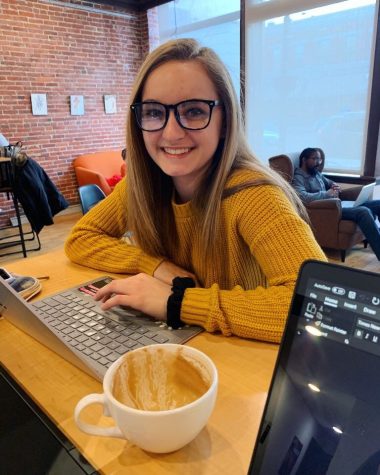Students commemorate Yom Hashoah with digital displays
April 14, 2021
In the midst of a hectic, ever-changing world it is important to take time and reflect on history, even those moments that are most difficult to look upon.
President Joseph Biden proclaimed the week of April 4 through 11 as “Days of Remembrance of Victims of the Holocaust” in recognition of both the victims and survivors who experienced the horrors of the Holocaust of World War II.
More specifically, the Israeli Holocaust Remembrance Day, Yom Hashoah, is commemorated from sundown on April 7 to sundown on April 8. According to the International Fellowship of Christians and Jews, the purpose of this day is to honor “the six million Jewish men, women and children who were brutally murdered at the hands of the Nazi regime.”
To help bring light to the purpose of this week, and more specifically Yom Hashoah, students of the History & Memory of the Holocaust course and assistant professor of History, Averill Earls, Ph.D., created displays to help educate the general Mercyhurst community.
“Public historians build bridges between the past and the present. Students of the History & Memory of the Holocaust course have built a bridge of remembrance between the Holocaust and the Mercyhurst community,” said Earls. “We hope that students, faculty and staff took a few minutes to learn and reflect this week.”
Earls tasked the students to apply what they learned in the class to an educational experience that could be shared with others, which led to the development of the displays. This project is unique in the sense that it combines physical and digital media, which allows the digital media to remain long after the posters are taken down.
Senior Political Science and History double major, Trey Catalano, described the assignment.
“As a class, we created an online exhibit that housed and displayed our research on various topics. This includes our research papers, a short podcast and some images/archive sources on a webpage that can be accessed via QR codes on posters,” Catalano said.
Catalano’s research focused on a provision in the early 20th-century German Penal code, paragraph 175, which criminalized same-sex desiring men.
“I learned that Berlin was the hub for what was arguably the first modern gay rights movement. There were numerous grassroots efforts during the Weimar Republic era to repeal this statute as activists signed petitions to be brought before the legislature,” said Catalano. “Influential figures, such as Magnus Hirschfeld, were able to organize these movements in the 1920s. While these initiatives unfortunately failed, it was still impressive to learn about this often-overlooked portion of history.”
Another interesting aspect of this project is that there were students who elected to participate, even though it was not required.
Because History & Memory of the Holocaust is an FAST course, students have the option to either take it as a 300-level major course or a 100-level REACH credit. Though the project was required for those taking it as a major course, it was an option for those taking it as a 100-level course. Still, three of the five students who were given the option chose to participate.
“That, to me, speaks volumes to how impactful learning this history is, and also how incredible Mercyhurst students are,” Earls said.
One such student who elected to participate is junior Early Childhood Education and Special Education major, Mary Claire Cousins.
“I wrote a paper called ‘Disability, Eugenics and Euthanasia in the Holocaust’ and recorded a podcast episode of me reading part of it for the website,” said Cousins. “I also wrote a large portion of the ‘History’ portion of the website and helped install the bulletin boards around campus.”
Cousins was able to apply knowledge she learned from previous classes in her major to further her research into this subject.
“As an education major, I’ve learned a lot about eugenics and sterilization in my classes already, but as I was researching for this paper I learned a lot more about the specific groups of people that were targeted and how the Nazis justified and executed the T4 program on such a monumental scale,” Cousins said.
As a whole, Earls and her students hope that those who saw the display were able to learn something from the physical and digital information provided to them. Earls in particular hopes that the displays prompted viewers to take a deeper look at the Holocaust.
“Genocides don’t just happen out of the blue. When we allow prejudice to shape laws, when we sit by complacently when those in power persecute minorities, we are culpable,” said Earls. “Rebekah Prather’s podcast hopefully reveals just how close to home the Holocaust hits. The Cleveland community actively protested German fascism and created homes for refugees. The research projects the students did ask us to think more deeply about experiences of the Holocaust, but also how we remember the Holocaust, and what role Americans could and did have in the resistance to German fascism.”
Catalano hopes that the project allowed for students and faculty alike to learn something new.
“My peers have done an incredible job researching and presenting on some really important subjects,” said Catalano. “Even if you just take a quick moment to look over some of their exhibits, I think you’ll find there’s a lot to learn from their work.”


Averill Earls • Apr 15, 2021 at 8:48 am
Though the exhibits are down, there are still posters that lead to the digital exhibit on professors’ doors throughout campus, and you can visit our digital display at averillearls.com/holocaust